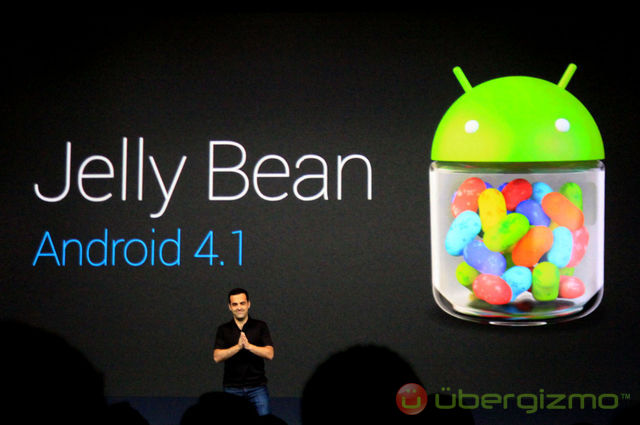
Android 4.1 Jelly Bean features a host of advancements that significantly elevate the user experience within the mobile operating system landscape. This update, rolling out to consumers by mid-July, is not just about aesthetic changes; it introduces remarkable functionalities that enhance Android performance across the board. Among its most notable innovations is “Project Butter,” which optimizes graphics rendering to achieve 60 frames per second, ensuring smooth navigation. Additionally, the Jelly Bean update brings a self-correcting home screen and a predictive keyboard that astutely guesses upcoming words, making typing more efficient. With new features like offline speech recognition and an improved notification system, Android 4.1 Jelly Bean solidifies itself as a pivotal release in the evolution of Google’s operating system, ensuring users enjoy a more intuitive and responsive interface.
The release of Android 4.1, often referred to by its codename Jelly Bean, marks a significant milestone in the evolution of mobile software. This powerful update is part of Google’s ongoing effort to refine and enhance the user experience on its devices. With a focus on performance improvements and user-friendly features, Jelly Bean introduces exciting tools that promote efficiency, such as enhanced voice recognition and a more interactive notification system. Beyond the name change, this version of the Google operating system integrates innovations that reflect changing user needs, establishing a sophisticated platform for both casual and professional smartphone users. As advancements in mobile technology accelerate, updates like Jelly Bean are pivotal in maintaining Android’s competitive edge.
Unveiling the Features of Android 4.1 Jelly Bean
Android 4.1 Jelly Bean introduces a plethora of enhancements that focus on optimizing the user experience. One of its standout features is ‘Project Butter,’ which revolutionizes the way Android operates by ensuring smooth and fluid animations. This update brings the entire operating system to run at a seamless 60 frames per second, making interactions notably responsive. Users will notice a significant improvement in CPU Touch Responsiveness, which ensures that the system reacts intelligently to user inputs, further elevating overall Android performance.
Moreover, Jelly Bean includes a self-correcting home screen arrangement, enhancing the flexibility of app management. Widgets automatically resize to fit available screen space, ensuring that users can customize their home screens without the previous constraints of static widget dimensions. This feature alone presents a more personalized experience, catering to user preferences while maintaining an organized layout that can adapt as needed.
Enhancements in User Interaction with Jelly Bean
The predictive keyboard introduced in Jelly Bean marks a significant leap forward for Android features. Users can enjoy a typing experience that anticipates their next word based on previous typed context. This feature not only speeds up the typing process but also reduces errors, making communication on mobile devices much more efficient. Coupled with enhanced Google Voice Search, which offers a question-and-answer format similar to Apple’s Siri, Jelly Bean effectively transforms how users interact with their devices.
In addition, the offline mode for speech recognition and voice typing allows users to dictate messages and commands without needing an active internet connection. This ensures that even in areas with poor connectivity, Android users still have access to vital features, significantly bolstering the usability of the Google operating system. Overall, these enhancements showcase Google’s commitment to improving user interaction within the mobile operating system.
The Impact of Jelly Bean on Photos and Notifications
With the introduction of Jelly Bean, the camera app undergoes substantial improvements, including a new review mode that allows users to seamlessly swipe through previously taken photos. The pinch-to-zoom functionality enables an intuitive browsing experience, similar to popular applications. This innovative approach to photo management ensures that users can efficiently view and manage their media, adding to the appeal of Android 4.1 as a versatile mobile operating system.
Furthermore, Jelly Bean enhances the notification system, allowing for actionable responses directly from the notification tray. This means users can initiate calls without fully opening the dialer or gain insights into their Gmail inbox with a single tap. The integration of social media interactions within notifications, like Google Plus updates, further modernizes the Android experience, making it more dynamic and user-friendly. It’s this keen attention to how users manage their digital lives that sets Android 4.1 apart from its predecessors.
Advancements in Connectivity: Android Beam and Beyond
Android Beam, a feature that enables data sharing between devices, is significantly upgraded in Jelly Bean. The system now leverages NFC to initiate communication, swiftly transitioning to Bluetooth for more substantial file transfers. This evolution not only facilitates easier sharing among peers but also demonstrates how Android continues to lead in creating a robust mobile ecosystem. With such connectivity improvements, users can effortlessly exchange photos, documents, and more, enhancing their overall mobile experience.
Additionally, Jelly Bean introduces multicast DNS-based service discovery, enabling applications to locate and connect with services offered by nearby devices over Wi-Fi. This innovation represents a critical step toward smarter device networking, allowing for instantaneous interaction without cumbersome setup processes. With these advancements, Android 4.1 positions itself as a frontrunner in the competitive landscape of mobile operating systems.
Innovative Accessibility Features in Jelly Bean
Android 4.1 Jelly Bean brings a host of accessibility features designed to empower visually impaired users. Gesture Mode allows for enhanced interaction through a clever combination of touch and voice, providing nuanced control over device functionality. These considerations not only broaden the scope of who can effectively use Android devices, but they also reaffirm Google’s commitment to inclusivity within their mobile operating system.
The update’s tailored experiences for all users emphasize the Android ethos of versatility and accessibility. By integrating these features, Google ensures that the advancements in Android 4.1 Jelly Bean are not merely for the tech-savvy, but for everyone, allowing people with different needs to harness the full potential of their devices with relative ease.
Streamlined Performance Enhancements in Jelly Bean
Jelly Bean emphasizes performance tweaks that largely benefit Android users’ day-to-day interactions. Through Project Butter, the entire user interface becomes remarkably more fluid, addressing common performance issues seen in earlier versions. These under-the-hood improvements manifest in faster app launches and reduced lag when switching between applications, significantly enhancing the overall efficiency of the Google operating system.
This commitment to smooth operations extends beyond mere aesthetics; it impacts how users engage with their devices on a functional level, ensuring that multitasking capabilities are reliable and responsive. As more users rely on Android for both personal and professional tasks, these enhancements position Jelly Bean as a notable update in the evolution of mobile operating systems.
Expanding Language Support with Jelly Bean
In an increasingly globalized world, language support is critical for mobile operating systems, and Android 4.1 Jelly Bean rises to meet this challenge by adding support for numerous input languages. Users can now enjoy greater accessibility with languages such as Arabic, Hebrew, Persian, Hindi, and Thai, allowing for a richer interaction with devices. This expansion showcases Google’s dedication to inclusivity, ensuring that users can communicate effectively in their preferred language.
Moreover, the addition of bi-directional text support allows users to seamlessly switch between languages that read in opposite directions. This thoughtful accessibility feature not only enhances user experience but also signifies the evolution of Android as a truly global mobile operating system caterer. By prioritizing language inclusivity, Jelly Bean sets a strong precedent for future updates and developments.
The Future of Android with Jelly Bean and Subsequent Updates
Android 4.1 Jelly Bean lays the groundwork for future iterations of the mobile operating system, ensuring that core experiences are not only innovative but also built with user needs in mind. The consistent emphasis on performance, accessibility, and connectivity has created a solid structure upon which future updates can build. As Google continues to innovate, these foundational enhancements will remain central to the Android lifecycle.
With the evolving landscape of mobile technology, Jelly Bean stands as a testament to how Google prioritizes user experience through thoughtful updates. The progressive features introduced pave the way for subsequent versions, promising a future where Android continues to lead the charge in performance and usability, setting benchmarks for other mobile operating systems to aspire to.
Real-World Implications of Android 4.1 Updates
The release of Android 4.1 Jelly Bean has considerable real-world implications for device manufacturers, developers, and users. For manufacturers, the necessity to integrate Jelly Bean features into new devices means a shift in production strategies to meet consumer demands for speed, functionality, and accessibility. Likewise, developers are challenged to adapt their applications to leverage the new capabilities, such as the predictive keyboard and enhanced notifications.
For users, the implications are overwhelmingly positive. Advances in Android performance realize a more responsive, enjoyable experience, making devices feel faster and more intuitive. The incremental updates showcased in Jelly Bean ensure that even those on older hardware can experience a significant enhancement in usability, thus bridging the technological divide among users across varying devices.
Frequently Asked Questions
What are the key features of the Android 4.1 Jelly Bean update?
The Android 4.1 Jelly Bean update introduced several key features including ‘Project Butter’ for smoother performance at 60 frames per second, a self-correcting home screen arrangement, an improved predictive keyboard, offline speech recognition, and enhanced accessibility features like Gesture Mode. Additionally, users enjoy an improved notification system and a fully integrated Google Chrome browser.
How does Project Butter improve Android performance in Jelly Bean?
Project Butter enhances Android performance by optimizing the way the mobile operating system renders and displays graphics. With Android 4.1 Jelly Bean, the entire interface runs at 60 frames per second, ensuring smoother animations and improved touch responsiveness when interacting with the device, which significantly enhances user experience.
What is the predictive keyboard feature in Android 4.1 Jelly Bean?
The predictive keyboard in Android 4.1 Jelly Bean is designed to enhance typing efficiency by guessing the next word based on the context of the conversation. This feature not only speeds up text input but also improves accuracy, making communication faster and more intuitive in this Google operating system.
How does the new notification system in Jelly Bean enhance user experience?
The improved notification system in Android 4.1 Jelly Bean allows for actionable notifications, meaning users can perform actions directly from the notification menu, such as calling a contact or viewing a full inbox in Gmail. This feature streamlines interaction with notifications, reducing the need to open apps and enhancing overall Android functionality.
What enhancements were made to voice recognition in Android 4.1 Jelly Bean?
Android 4.1 Jelly Bean brought significant improvements to voice recognition, featuring offline mode for speech input and introducing a Google Voice Search that mimics question and answer functionalities, akin to Apple’s Siri. This makes the mobile operating system more versatile and user-friendly, even without an Internet connection.
What is Android Beam in Jelly Bean and how does it work?
Android Beam is a feature in Android 4.1 Jelly Bean that allows for seamless data transfer between devices using NFC. When devices are brought close together, information can be exchanged through NFC, with the transfer switching to Bluetooth for larger files, enhancing inter-device communication in this Google operating system.
Which languages does Android 4.1 Jelly Bean support for input?
Android 4.1 Jelly Bean expanded input language support to include Arabic, Hebrew, Persian, Hindi, and Thai among others. This also introduced bi-directional text support, making the mobile operating system more accessible to a diverse range of users globally.
How does the Jelly Bean Camera app improve photo management?
In Android 4.1 Jelly Bean, the Camera app introduced a new review mode that allows users to quickly manage their photos by zooming out to a ‘filmstrip view’. This feature enables easier swiping to discard unwanted images, improving photo management efficiency and enhancing usability for users capturing moments.
| Key Features | Description | |
|---|---|---|
| Project Butter | Improves performance and responsiveness, operating at 60 fps. | |
| Self-Correcting Home Screen | Widgets resize automatically; app shortcuts realign around them. | |
| Predictive Keyboard | Guesses the next word of messages based on context. | |
| Offline Speech Recognition | Allows voice typing without an internet connection. | |
| Multi-Language Support | Includes Arabic, Hebrew, Persian, Hindi, and Thai; supports bi-directional text. | |
| Gesture Mode | Enhanced for visually impaired users, combining touch and voice commands. | |
| Camera App Review Mode | Pinch to zoom out to filmstrip view for easy photo management. | |
| Android Beam | Transfers data via NFC, switching to Bluetooth for transfer. | |
| Chrome Browser Integration | Replaces stock browser for a more modern browsing experience. | |
| Improved Notification System | Allows direct actions from notifications, making them interactive. | |
| Enhanced Google Voice Search | New question and answer format similar to Siri. | |
| Multicast DNS Support | Enables discovery of services offered by devices over Wi-Fi. | |
Summary
Android 4.1 Jelly Bean features a variety of improvements aimed at enhancing user experience and performance. With the introduction of “Project Butter,” the system runs more smoothly and responsively at 60 frames per second. Other notable features include a self-correcting home screen, a predictive keyboard, offline speech recognition, and support for multiple languages. The updated camera app and lively notification system enhance interactivity and usability, bringing Android in line with the latest mobile innovations. Overall, Android 4.1 Jelly Bean represents a significant step forward in refining the Android operating system.



